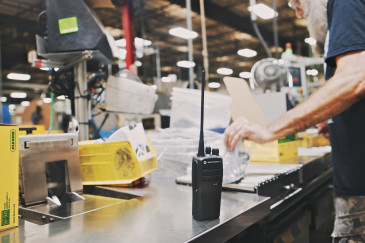Second of a three-part series.
If you’re buying two-way radios (walkie-talkies) for your organization, you need to do it right and get an FCC license. If you don’t, you’re probably breaking the law.* Besides, there are also ample rewards for operating your radios by the book. For example, you have recourse if other radio operators are making a nuisance of themselves on channels assigned to you. If you’re unlicensed, you’re out of luck.
Though people can find plenty to gripe about when it comes to the government, wireless communication is one place where we need an agency to set rules that reasonable people can agree on — getting the most equitable use of our limited airwaves.
What are the key components of our regulated radio spectrum and why is FCC supervision the glue that holds it all together?
 To put this in perspective, let’s say you own a department store less than 50 yards from a fast-food restaurant. Both of you need two-way radios to offer great customer service, but it creates problems when somebody’s double-cheeseburger order interferes with your clerk checking a price. In a more critical example, say your office complex is using two-way radios to communicate in an emergency situation, and channel interference from other near-by users is garbling messages when lives may be at stake. Since the FCC knows about all the radios in these locations, it can assign channels to minimize the chances of users getting in each other’s way.
To put this in perspective, let’s say you own a department store less than 50 yards from a fast-food restaurant. Both of you need two-way radios to offer great customer service, but it creates problems when somebody’s double-cheeseburger order interferes with your clerk checking a price. In a more critical example, say your office complex is using two-way radios to communicate in an emergency situation, and channel interference from other near-by users is garbling messages when lives may be at stake. Since the FCC knows about all the radios in these locations, it can assign channels to minimize the chances of users getting in each other’s way.
 MOTOROLA, MOTOROLA SOLUTIONS and the Stylized M Logo are trademarks or registered trademarks of Motorola Trademark Holdings, LLC and are used under license. All other trademarks are the property of their respective owners. ©2015 Motorola Solutions, Inc. All rights reserved.
MOTOROLA, MOTOROLA SOLUTIONS and the Stylized M Logo are trademarks or registered trademarks of Motorola Trademark Holdings, LLC and are used under license. All other trademarks are the property of their respective owners. ©2015 Motorola Solutions, Inc. All rights reserved.
Radio Basics: Bandwidth is a Scarce Resource
The laws of physics determine that radio waves move at certain frequencies. The radio frequency, or RF band, is sliced up in multiple ways with sections set aside for TV, Bluetooth, WiFi, RFID and other devices that transmit and receive radio signals. However, one of the limitations of radio is that only one signal can use a specific frequency at any given time. Two factors define the limits of a radio:- The airwaves must be shared.
- Frequencies must be assigned to prevent too many people from using the same channels at the same time.
What the FCC Does
Imagine no rules determining which channels are assigned to TV stations or cell phone companies. It would be a fiasco. The FCC works with RF users and determines guidelines for how to assign frequencies to each of the various interest groups. Demand for cell phone channels is so strong that the FCC auctions off sections of bandwidth for billions of dollars. Ham radio enthusiasts sustain an industry and provide vital assistance in emergencies when phones and other means of communication have gone dead, so the FCC also does what it can to accommodate them. The simple radios that parents take to the mall to talk to their kids have a few assigned frequencies that everybody has to share. The FCC also recognizes that a broad spectrum of businesses and industries need the simple push-to-talk efficiency and communications flexibility that two-way radios offer, so they have their bands too. In the commercial/professional radio class, specific frequencies are assigned to your company or organization.The Value of a FCC License for your Business Radios
When you apply to the FCC, you reveal everything about your setup: the number of radios, the number of users, the power of your base station and the height of your tower, if you need one. The FCC keeps a database of every radio license to prevent people from stepping on each other’s signals. To put this in perspective, let’s say you own a department store less than 50 yards from a fast-food restaurant. Both of you need two-way radios to offer great customer service, but it creates problems when somebody’s double-cheeseburger order interferes with your clerk checking a price. In a more critical example, say your office complex is using two-way radios to communicate in an emergency situation, and channel interference from other near-by users is garbling messages when lives may be at stake. Since the FCC knows about all the radios in these locations, it can assign channels to minimize the chances of users getting in each other’s way.
To put this in perspective, let’s say you own a department store less than 50 yards from a fast-food restaurant. Both of you need two-way radios to offer great customer service, but it creates problems when somebody’s double-cheeseburger order interferes with your clerk checking a price. In a more critical example, say your office complex is using two-way radios to communicate in an emergency situation, and channel interference from other near-by users is garbling messages when lives may be at stake. Since the FCC knows about all the radios in these locations, it can assign channels to minimize the chances of users getting in each other’s way.
Assistance with FCC Licensing
Wireless dealers like BearCom make it easy to apply for a license so that you don’t need to worry about understanding or navigating through the complexities of licensing management. Additional information about BearCom’s FCC Licensing Services. For assistance with your FCC licensing, contact Support Services at 800.458.9887. Or, email: [email protected] *Note that some commercial two-way radios operating on MURS frequencies or on the ISM band do not require licensing.Related Articles:
About BearCom
BearCom provides a broad line of high-performance wireless communications products, services, and complete mobility solutions. Founded in 1981, BearCom is America’s only nationwide dealer and integrator of wireless communications equipment, serves customers from 29 branch offices located throughout the U.S., and employs approximately 360 people. BearCom is headquartered in the Dallas, Texas area. MOTOROLA, MOTOROLA SOLUTIONS and the Stylized M Logo are trademarks or registered trademarks of Motorola Trademark Holdings, LLC and are used under license. All other trademarks are the property of their respective owners. ©2015 Motorola Solutions, Inc. All rights reserved.
MOTOROLA, MOTOROLA SOLUTIONS and the Stylized M Logo are trademarks or registered trademarks of Motorola Trademark Holdings, LLC and are used under license. All other trademarks are the property of their respective owners. ©2015 Motorola Solutions, Inc. All rights reserved.




